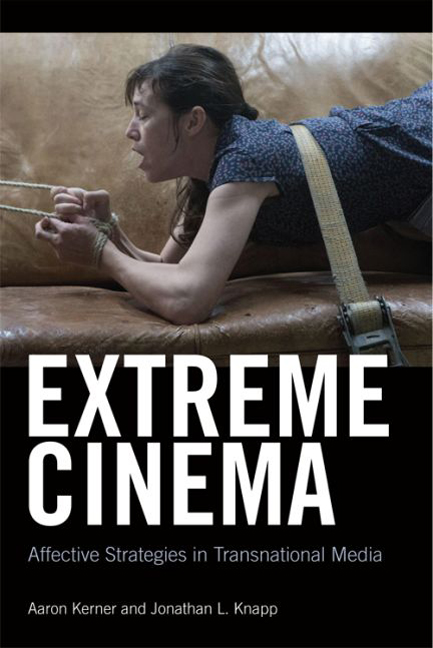Book contents
- Frontmatter
- Contents
- List of Figures
- Acknowledgments
- 1 Extreme Cinema: Revisiting Body Genres
- 2 Hearing: With a Touch of Sound—The Affective Charge of Audio Design
- 3 Pain: Exploring Bodies, Technology, and Endurance
- 4 Laughter: Belly-aching Laughter
- 5 Arousal: Graphic Encounters
- 6 Crying: Dreadful Melodramas—Family Dramas and Home Invasions
- 7 The End of Extreme Cinema?
- Bibliography
- Filmography
- Index
5 - Arousal: Graphic Encounters
- Frontmatter
- Contents
- List of Figures
- Acknowledgments
- 1 Extreme Cinema: Revisiting Body Genres
- 2 Hearing: With a Touch of Sound—The Affective Charge of Audio Design
- 3 Pain: Exploring Bodies, Technology, and Endurance
- 4 Laughter: Belly-aching Laughter
- 5 Arousal: Graphic Encounters
- 6 Crying: Dreadful Melodramas—Family Dramas and Home Invasions
- 7 The End of Extreme Cinema?
- Bibliography
- Filmography
- Index
Summary
Understanding fleshly languages as languages—structured systems of intelligent communication whose matter is intrinsic to their form— enhances the likelihood that science will identify more of them.
INTRODUCTION: SEDUCTION
Taken on their own, sounds such as grunts, sighs, heavy breathing, or screaming might just as easily signify pain as sexual excitation. Similarly, divorced of any establishing shot, a tight close-up of a face forcefully pinched up, mouth agape, might very well be difficult to read. Recall, for instance, Stan Brakhage's silent short film Window Water Baby Moving (1959), which documents Jane Brakhage's birthing of the couple's first daughter. Individual shots, particularly close-ups of Jane's face, are easily confused for ecstatic frenzy, but given the situation clearly register the pain of childbirth. And it is precisely this confusion, which Brakhage obviously “plays with,” that prompted Carolee Schneemann to make her frank erotic experimental film Fuses (1965).
Tsai Ming-liang's 2005 film The Wayward Cloud is not an extreme film in the way that Hostel is, for example. Nonetheless, these films are comparable in their manipulation of (aural) signifiers of pain and ecstasy (recall Josh's misrecognition of the sounds of a consensual BDSM encounter as those of violation). Structurally, though, The Wayward Cloud approaches extreme cinema, as its conventional dramatic narrative hosts ruptures—seemingly LSD-inspired Busby Berkeley song-and-dance numbers as well as fairly frank sex scenes. Like Window Water Baby Moving, Tsai's film conflates sexual ecstasy with childbirth. Shiang-chyi, the central female character, mounts the stairs of her apartment block with a large watermelon under her shirt, making it appear she is pregnant. Suddenly she collapses, evidently overwhelmed with contractions. She pants and grunts, and as much as the act reflects the birthing process, it is mildly erotic insofar as the semiotic utterances, the supposed paroxysmal collapse due to pain (or is it ecstasy?), the splaying of her legs, her prone posture, her pursed lips, heavy breathing which climaxes with orgasmic wailing as the melon emerges from under her shirt—all these bodily expressions might be confused with signifiers of arousal. The slippage of signifiers is not an accident; clearly this is what Tsai intends, because the very next shot cuts to a Japanese porn actress—completely naked—masturbating on a kitchen counter with a water-bottle.
- Type
- Chapter
- Information
- Extreme CinemaAffective Strategies in Transnational Media, pp. 101 - 129Publisher: Edinburgh University PressPrint publication year: 2016



